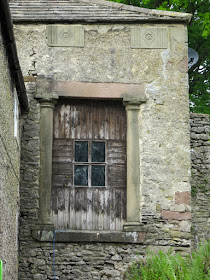 |
| A general view in Cadeby Quarry |
During my investigation of the construction history and building stones of mediaeval churches in and around South Yorkshire, I have encountered numerous examples of dolomitic limestone from the Permian Cadeby Formation – with considerable variation in colour and texture - either as the principal building stone or used for dressings.
 |
| General views of the exterior and interior of St. Helen's church |
At St. Helen’s church in Treeton, where I live, this ‘Magnesian Limestone’ has been used for the C12 north arcade, the plinth to the C13 chancel, for windows in the later mediaeval additions and, most notably, for the early C16 addition to the tower.
 |
| The south door at St. Helen's church |
Some window tracery and the arch to the porch was replaced with Jurassic oolitic limestone in the C19 and, although Treeton was downwind of the Orgreave Coking Plant for many years, much of the remaining plain stone and simple mouldings are still in generally sound condition.
 |
| Decaying limestone to the arch of the priest's door at St. Helen's church |
The stone in the arch to the priest’s door on the north elevation of the chancel and the right hand moulded jamb of the Norman south door have decayed considerably and, like very much of the Rotherham Red sandstone - which is quite soft and has developed extensive cavernous decay - these elements need restoring.
 |
| Cavernous decay in Rotherham Red sandstone |
Although not party to the decision making process at St. Helen’s church, I was curious to know what dolomitic limestones were still generally available and in preparation for my trip to Pontefract with the Sheffield U3A Geology Group, I was also interested in the stone that had been used for recent work at Pontefract Castle.
 |
| A view of the block store at Cadeby Quarry |
The limestone used at St. Helen’s church is very pale in colour and my first step was to contact Cadeby Quarry, where I knew from past experience that much of the stone supplied here was of a similar colour. Much to my surprise Iain Kennedy, who I met at George Farrar when sourcing sandstone for potential use at All Saints church in Pontefract, invited me to come and visit the quarry and see the operations of Blockstone Ltd.
 |
| The Dazzini chainsaw at work |
Although this time, I wasn’t undertaking paid consultancy work, he kindly collected me from Warmsworth – which I had reached on the bus – and then showed me the block store and their Dazzini chainsaw in action, which is the sole method used for extracting limestone blocks here.
 |
| The working quarry face at Cadeby Quarry |
I hadn’t realised how large this quarry is and, although only a small part is now quarried for dimensional stone, I was very interested to learn that 13 separate beds are distinguished and that at least one of them possesses very distinctive ripple marks, which I had previously seen in several mediaeval churches.
 |
| A display of various stones at Cadeby Quarry |
For specifiers, both for new build and restoration work, their full range of stones are set out as panels in what is effectively a long wall, which provides a good indication of the variation in colour and texture likely to be encountered – something that is not readily determined in the 150 mm square samples that are typically sent out in the post.
 |
| A detail of dolomitic limestone displays at Cadeby Quarry |
I didn’t knowingly get to see the Site of Special Scientific Interest (SSSI), which is described in the Geological Conservation Review but a visit to a quarry always adds a bit more to my knowledge of geology and, on this occasion, I spotted another bryozoan reef.
 |
| A bryozoan reef at Cadeby Quarry |
On the way back home, having already got a couple of samples in my rucksack, I took advantage of my wait for the X78 bus back to Rotherham by popping in to the showroom of Warmsworth Stone Ltd. – where I was given more samples from the Hazel Lane Quarry, which I had previously visited when undertaking the Doncaster Geodiversity Assessment.
 |
| The building magnesian limestones of the British Isles |
When finally arriving home, I completed my day by making further investigations about dolomitic limestone quarries that were listed in my copy of the Building Research Establishment (BRE) publication - “Building magnesian limestones of the British Isles”.
 |
| The brochure for Tadcaster Building Limestone |
Even though I was able to obtain further samples from the Highmoor Quarry in Tadcaster, which supplied stone for recent work to Selby Abbey, I discovered that several quarries listed were closed, no longer had planning permission or didn't respond to my request – a situation that may account for the use of Bath Stone for modern repairs to churches that are built of distinctly yellow dolomitic limestone, which I have seen recently.
 |
| Dolomitic limestone samples from Cadeby, Tadcaster and Hampole |



































